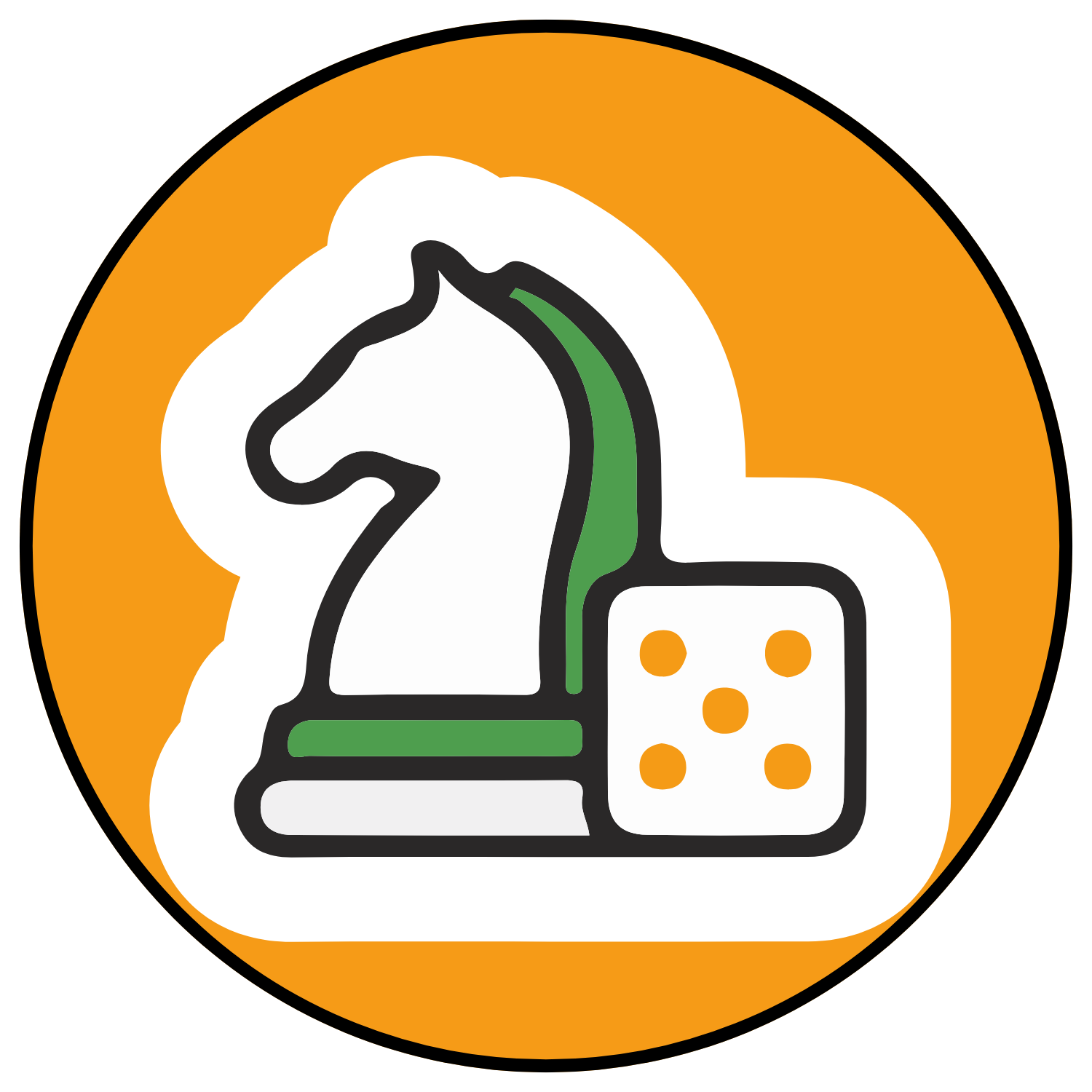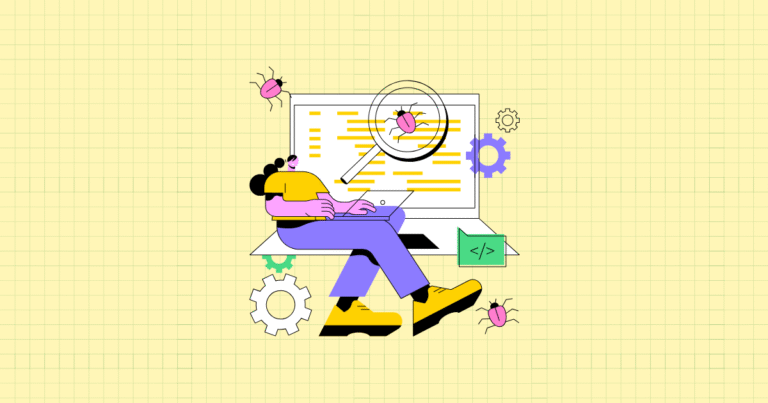Ever wonder why some Shopify stores convert browsers into buyers while others struggle to make sales despite decent traffic? The answer often lies in how well store owners understand and apply Conversion Rate Optimization (CRO) analytics. Those percentage points might seem small—but they’re the difference between thriving and merely surviving in the competitive e-commerce landscape.
Here’s a sobering reality check: Shopify’s average conversion rate hovers around 1.4%, which falls below general e-commerce averages. Think about that. For every 100 visitors to your store, only one or two are making purchases. The good news? This gap represents a massive opportunity for growth—without spending another dollar on advertising.
Small shifts in your conversion rate create ripple effects across your entire business. Bump that 1.4% to 2.8%, and you’ve doubled your revenue from the same traffic. It’s like finding money you didn’t know you had—hiding in plain sight within your store’s analytics.
Why Conversion Rate Optimization (CRO) Matters
CRO isn’t just another marketing buzzword; it’s the backbone of profitable e-commerce. When you optimize for conversions, you’re essentially maximizing the return on every marketing dollar spent. Why pay to bring more visitors to your store when you could be converting more of the ones already showing up?
The impact is tangible and immediate. Consider this: increasing your conversion rate from 1.4% to 2% might seem modest, but it represents a 43% increase in sales without increasing your traffic or ad spend. For a store making $10,000 monthly, that’s an additional $4,300 in revenue—with zero additional marketing costs.
But CRO isn’t a one-and-done project. Customer behaviors evolve, competitors adjust strategies, and what works today might fall flat tomorrow. That’s why successful store owners approach CRO as an ongoing process of testing, measuring, learning, and adapting.
Fortunately, Shopify puts powerful analytics tools at your fingertips. From native reporting features to an ecosystem of specialized apps, you have everything needed to transform browsing into buying—regardless of your technical expertise or budget.
Who Benefits from CRO Analytics and Measurement
Whether you launched your Shopify store yesterday or you’re managing a multi-million dollar operation, CRO analytics offers valuable insights tailored to your growth stage.
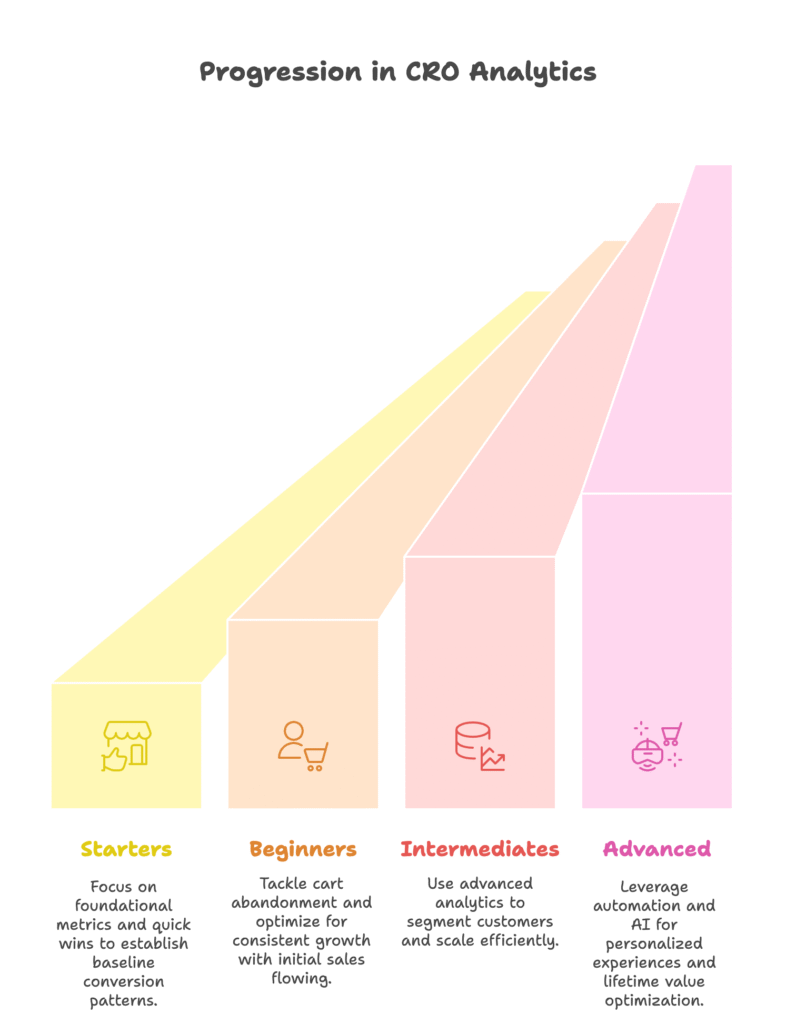
- Starters: Just setting up shop? Focus on foundational metrics and quick wins that help establish baseline conversion patterns. Even simple changes like improving product images or streamlining navigation can yield dramatic early results.
- Beginners: With initial sales flowing, you can now tackle cart abandonment and optimize for consistent growth. Your analytics will reveal patterns that help reduce drop-offs and increase customer confidence during checkout.
- Intermediates: As your store matures, advanced analytics become your competitive edge. Segment your customers, implement sophisticated testing strategies, and make data-driven decisions to scale efficiently.
- Advanced: At this level, you’re leveraging automation, AI-driven insights, and sophisticated testing frameworks. Your analytics focus shifts toward optimizing customer lifetime value and creating personalized shopping experiences at scale.
No matter where you fall on this spectrum, one thing remains constant: better analytics lead to better decisions, and better decisions lead to better conversion rates. Let’s dive into how you can set up, interpret, and act on CRO analytics in your Shopify store.
Foundations of CRO Analytics in Shopify
Before we jump into metrics and tools, let’s align on what CRO actually means in the context of your Shopify store. Understanding these foundations gives you the perspective needed to interpret your data effectively.
Defining CRO and Its Role in Shopify E-Commerce
Conversion Rate Optimization is the systematic process of increasing the percentage of visitors who take desired actions on your site. For most Shopify stores, the primary conversion is completing a purchase, but other valuable conversions include email signups, account creations, or adding products to wishlists.
Unlike general web analytics that might focus on traffic sources or page views, CRO zeros in on what actually generates revenue. It’s the difference between knowing 10,000 people visited your store (interesting) and knowing what percentage actually bought something (actionable).
CRO combines both quantitative data (numbers and metrics) and qualitative insights (customer feedback and behavior). This dual approach helps you understand not just what’s happening in your store but why it’s happening—giving you the complete picture needed for meaningful improvements.
What makes CRO particularly powerful for Shopify stores is its focus on incremental improvement through continuous testing. Rather than making wholesale changes based on hunches, you systematically test variations to discover what actually drives conversions for your unique audience and products.
Essential CRO Metrics for Shopify Stores
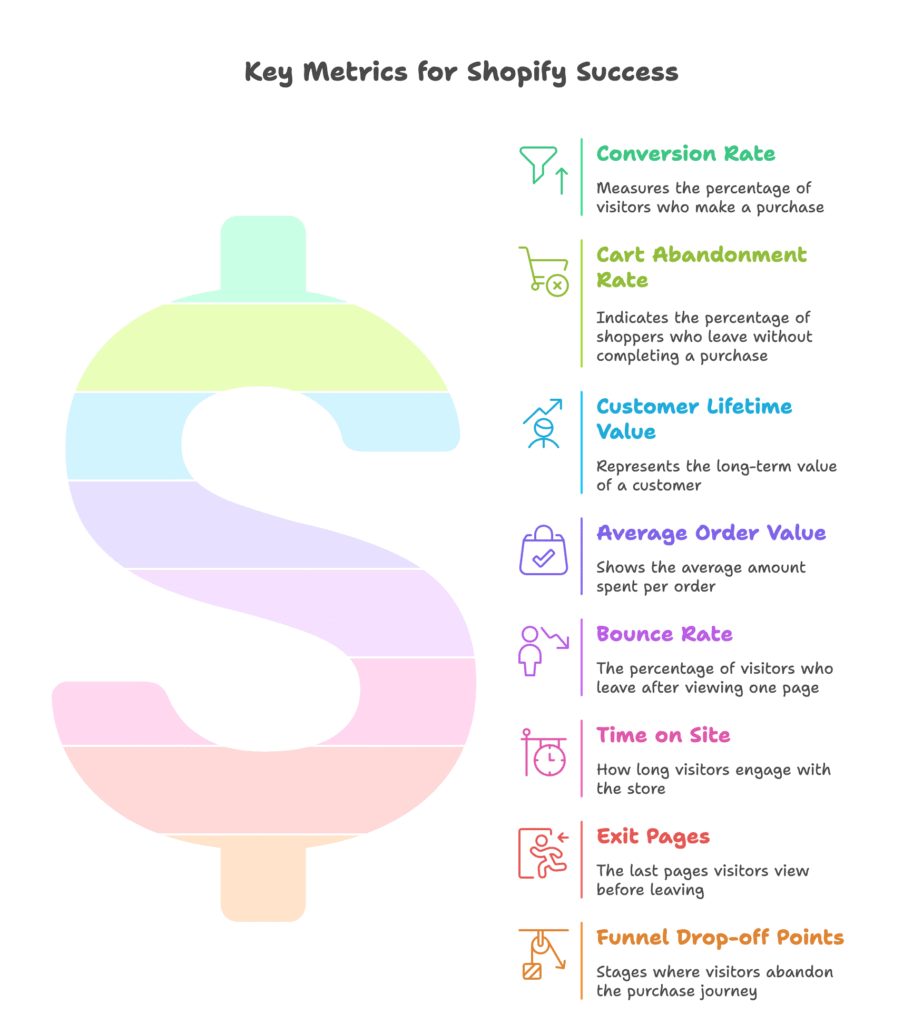
While dozens of metrics might seem important, focusing on these core KPIs will give you the clearest picture of your store’s conversion health:
1. Conversion Rate
This foundational metric is calculated as (Conversions ÷ Total Visitors) × 100. For example, if your store had 1,000 visitors and 20 purchases, your conversion rate would be 2%.
In Shopify, find this under Analytics > Reports > Sales by channel. Pay attention to how this rate varies across different channels (organic search, social media, paid ads) to identify your most effective traffic sources.
2. Cart Abandonment Rate
This metric reveals how many shoppers add products to cart but leave without completing the purchase. The industry average hovers around a sobering 70%—meaning nearly three-quarters of potential sales evaporate at the finish line.
Track this in your Shopify dashboard under Analytics > Reports > Abandoned checkouts. High abandonment rates often signal friction in the checkout process, unclear shipping costs, or last-minute hesitations about product value.
3. Customer Lifetime Value (CLV)
While conversion rate measures immediate sales, CLV reveals the long-term value of acquiring each customer. A high CLV justifies higher acquisition costs and informs retention strategies.
Shopify provides basic CLV insights through Analytics > Reports > Customer cohort analysis. This report shows how different customer groups contribute to revenue over time, helping you identify your most valuable customer segments.
4. Average Order Value (AOV)
Calculated as Total Revenue ÷ Number of Orders, AOV directly impacts profitability. Increasing your AOV can be easier than increasing your conversion rate, making it a high-leverage metric to optimize.
Monitor this in Shopify’s sales reports, and consider strategies like product bundles, volume discounts, or free shipping thresholds to encourage larger purchases.
5. Additional Metrics
Beyond these primary metrics, you’ll want to track:
- Bounce rate: The percentage of visitors who leave after viewing just one page.
- Time on site: How long visitors engage with your store before leaving.
- Exit pages: The last pages visitors view before departing, which often indicate problem areas.
- Funnel drop-off points: Specific stages where visitors abandon the purchase journey.
These metrics paint a comprehensive picture of the customer journey, highlighting where shoppers get stuck or lose interest. By addressing these friction points, you systematically improve your overall conversion rate.
Setting Up CRO Analytics on Shopify
With a clear understanding of key metrics, let’s set up the tools you’ll need to track, analyze, and act on this data. Shopify provides robust native analytics, but you’ll also benefit from strategic third-party integrations.
Leveraging Shopify’s Native Analytics Tools
Shopify comes equipped with powerful analytics capabilities that require minimal setup. Let’s make sure you’re taking full advantage of these built-in resources.
1. Shopify Analytics Dashboard
Your command center for conversion insights lives at Analytics > Dashboard in your Shopify admin. This overview provides at-a-glance metrics on sales, customer behavior, marketing performance, and inventory levels.
For CRO purposes, pay special attention to the “Online store conversion rate” card, which tracks changes over time. The “First-time vs. returning customer sales” breakdown is equally valuable, as it helps you tailor optimization efforts to different customer segments.
Pro tip: Customize your dashboard by clicking “Add card” to prioritize the metrics most relevant to your conversion goals. This keeps critical KPIs front and center during your daily store management.
2. Shopify Reports for CRO
Beyond the dashboard, Shopify offers detailed reports that provide deeper conversion insights:
- Abandoned Checkouts: Identifies products frequently abandoned and the checkout stage where drop-offs occur.
- Product Analytics: Shows which products attract interest but don’t convert, helping you identify pages needing optimization.
- Sales by Channel: Reveals which traffic sources deliver the highest conversion rates, allowing you to double down on effective channels.
- Customer Cohort Analysis: Tracks how different customer groups behave over time, informing retention strategies.
Schedule these reports for regular delivery to keep conversion optimization top-of-mind. Export critical reports to CSV for deeper analysis or sharing with team members who don’t have Shopify admin access.
Integrating Third-Party Analytics Solutions
While Shopify’s native tools provide an excellent foundation, third-party integrations offer enhanced capabilities for serious CRO efforts.
1. Google Analytics (GA4)
Google Analytics 4 delivers powerful e-commerce tracking capabilities that complement Shopify’s built-in analytics. Key advantages include:
- Detailed funnel visualization to identify precise drop-off points
- Advanced segment analysis for targeted optimization
- Cross-device and cross-channel tracking for complete customer journey mapping
- Custom goal tracking for non-purchase conversions
Implementation is straightforward: Navigate to Online Store > Preferences in your Shopify admin, paste your GA4 tracking code in the designated field, and save. Alternatively, use a dedicated Shopify app like “Google Analytics by Elevar” for enhanced e-commerce tracking setup.
2. Heatmaps and Session Recording Tools
Numbers tell you what’s happening, but heatmaps and session recordings show you why it’s happening. Tools like Hotjar and Lucky Orange provide visual insights into user behavior that quantitative data alone can’t reveal.
These tools display where visitors click, how far they scroll, and what elements they interact with—making invisible user behavior visible. Watch actual shopping sessions to identify usability issues, confusing elements, or missed opportunities for conversion prompts.
Installation typically involves adding a simple code snippet to your Shopify theme. Most providers offer straightforward setup guides specific to Shopify stores.
3. CRO-Focused Shopify Apps
The Shopify App Store offers specialized tools that combine analytics with action:
- Privy: Captures exit intent and offers targeted promotions while tracking conversion impact.
- Blyp: Provides AI-powered analytics with actionable recommendations specific to your store.
- Yotpo: Offers review analytics that connect customer feedback to conversion patterns.
- Smile: Tracks how loyalty programs influence repeat purchase behavior.
- Firepush: Measures the conversion impact of automated messaging across channels.
When evaluating CRO apps, prioritize those with built-in A/B testing capabilities. This allows you to measure the actual conversion impact of any changes before fully implementing them.
Data Collection and Analysis Techniques
With your analytics infrastructure in place, it’s time to collect and analyze data in ways that reveal actionable insights.
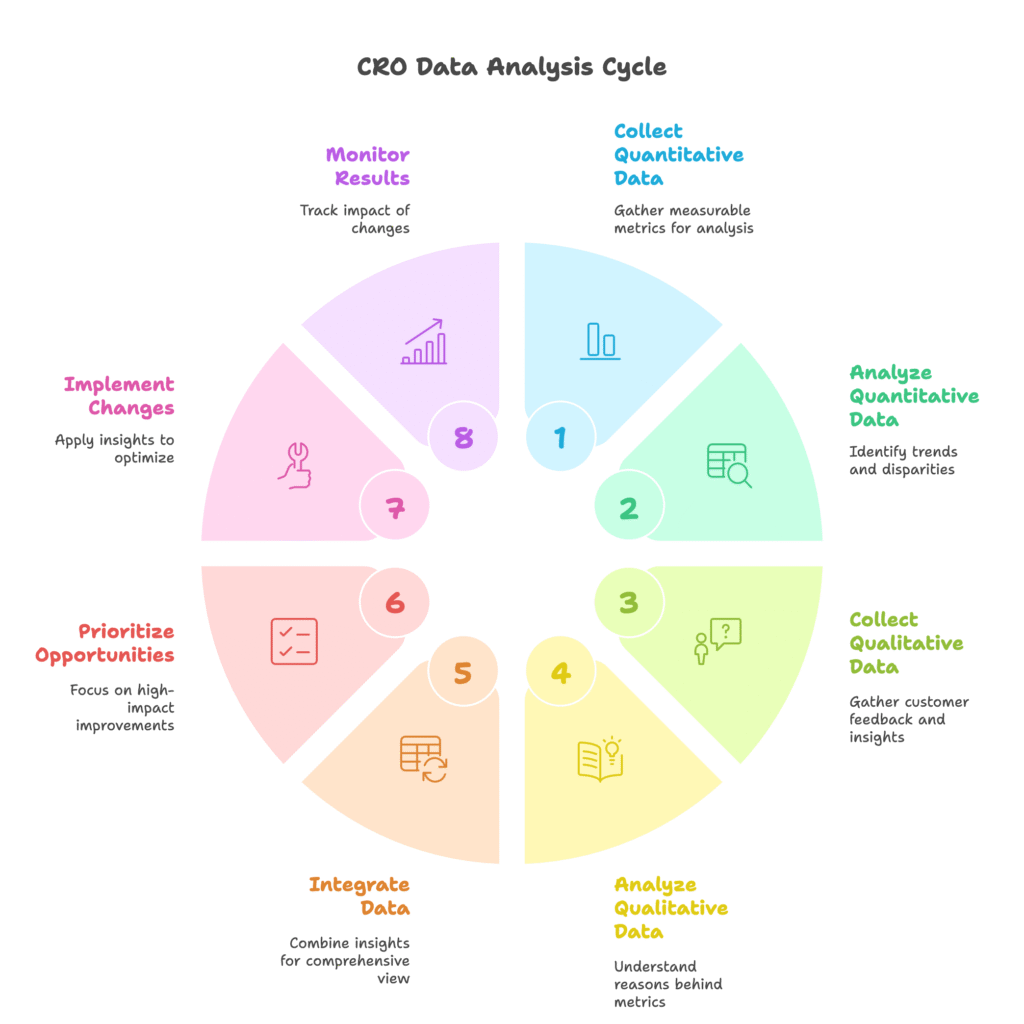
Effective CRO requires both quantitative and qualitative approaches—numbers tell you what’s happening while customer feedback explains why.
Quantitative Data Collection
Quantitative data provides the measurable metrics that form the backbone of your CRO strategy. Here’s how to collect and analyze it effectively:
1. Traffic and Conversion Segmentation
Not all traffic is created equal. Breaking down your conversion data by key segments reveals optimization opportunities that aggregate metrics might miss:
- Device: Compare conversion rates across desktop, tablet, and mobile to identify device-specific issues. Mobile conversion rates typically lag behind desktop by 30-50%, representing a significant optimization opportunity.
- Traffic source: Segment by direct visitors, organic search, paid ads, social media, and email campaigns. Disparities often indicate messaging misalignment between ads and landing pages.
- Landing page: Identify your highest and lowest-converting entry points. Top performers can provide templates for improving underperforming pages.
- Geographic location: Regional conversion differences might signal issues with shipping options, currency display, or localization needs.
Use Shopify Analytics alongside Google Analytics to perform this segmentation. Look for conversion rate disparities of 20% or more between segments—these represent your most promising optimization targets.
2. Funnel Analysis
Mapping your conversion funnel reveals exactly where potential customers drop off during the purchase journey. A typical Shopify funnel includes:
- Landing page view
- Product page view
- Add to cart
- Initiate checkout
- Complete purchase
For every 100 visitors entering this funnel, you might see 30 reach product pages, 10 add items to cart, 5 begin checkout, and 1-2 complete a purchase. Each stage represents a critical conversion point to optimize.
Use Google Analytics’ Funnel Visualization or Enhanced E-commerce reports to identify your largest drop-off points. These represent your highest-leverage optimization opportunities—areas where small improvements yield significant conversion gains.
Qualitative Data Collection
While numbers show what’s happening, qualitative data reveals why it’s happening. These techniques help you understand the human factors behind your conversion metrics:
1. On-Site Surveys and Feedback
Direct customer feedback provides insights that analytics alone can’t capture. Implement strategic surveys at key moments in the customer journey:
- Exit-intent surveys: Ask visitors why they’re leaving without purchasing.
- Post-purchase surveys: Learn what almost prevented customers from completing their order.
- Cart abandonment follow-ups: Email customers who didn’t complete checkout to understand their hesitations.
Keep questions focused and limited. A single, specific question like “What prevented you from completing your purchase today?” often yields more actionable insights than lengthy questionnaires.
2. Session Recordings and Heatmaps
Watching real users interact with your store reveals friction points that analytics might miss. Pay attention to:
- Rage clicks: Repeated clicks in the same area indicate user frustration with non-responsive elements.
- Scroll depth: If visitors rarely scroll below the fold, crucial information or calls-to-action might be missed.
- Form interactions: Identify which form fields cause hesitation or abandonment during checkout.
- Navigation patterns: See how users actually explore your store versus how you expected them to.
Tools like Hotjar and Lucky Orange provide these visual insights with minimal setup. Review 10-15 recordings weekly to develop an intuitive understanding of how customers experience your store.
3. Customer Reviews and Support Interactions
Your existing customer communications contain valuable CRO insights. Regularly audit:
- Product reviews: Look beyond star ratings to identify specific concerns or confusion points.
- Support tickets: Common pre-purchase questions highlight information gaps on your product pages.
- Live chat transcripts: Analyze conversations to identify recurring obstacles in the purchase journey.
Create a system to categorize and quantify these insights, transforming qualitative feedback into trends you can measure and address. For example, if 30% of support questions relate to shipping policies, that page clearly needs optimization.
Combining Data for Actionable Insights
The magic happens when you combine quantitative and qualitative findings. This integration transforms raw data into clear optimization priorities:
Start by identifying your largest conversion drops quantitatively, then use qualitative data to understand why they’re occurring. For example, if your checkout abandonment rate is 75%, session recordings might reveal that shipping costs are only displayed at the final step—creating sticker shock that drives abandonment.
Cross-reference findings across multiple data sources before making significant changes. When quantitative metrics, user feedback, and visual analytics all point to the same issue, you can be confident in prioritizing that fix.
Document these cross-validated insights in a CRO roadmap that ranks opportunities by potential impact and implementation difficulty. This structured approach ensures you’re always working on the highest-leverage improvements first.
Measurement, Reporting, and Goal Setting
With data collection systems in place, you need a framework for measuring progress, reporting results, and setting meaningful goals. This structure transforms CRO from occasional experiments into a systematic growth engine.
Establishing CRO Benchmarks and KPIs
Effective optimization requires clear benchmarks to measure progress against. Start with these reference points:
1. Industry and Shopify-specific benchmarks
While the average Shopify store conversion rate is approximately 1.4%, this benchmark varies significantly by industry:
- Health & Beauty: 3.0-4.5%
- Fashion & Apparel: 1.0-2.5%
- Electronics: 1.0-1.8%
- Home & Garden: 1.5-2.5%
- Food & Beverage: 1.7-3.3%
Use these industry averages as initial targets, but remember: your own historical performance is often the most relevant benchmark. Many successful stores significantly outperform category averages through consistent optimization.
2. Defining Success Metrics
Beyond conversion rate, establish KPIs for each stage of your customer journey:
- Engagement metrics: Pages per session, time on site, bounce rate
- Product interest metrics: Product page views, add-to-cart rate
- Checkout metrics: Cart abandonment rate, checkout completion rate
- Post-purchase metrics: Repeat purchase rate, customer lifetime value
Set specific improvement targets for each metric based on your current performance and industry standards. For newer stores, focus on relative improvement (e.g., “increase conversion rate by 20% quarter-over-quarter”) rather than absolute targets.
Creating and Interpreting CRO Reports
Regular reporting keeps optimization efforts on track and communicates progress to stakeholders. Here’s how to build effective CRO reporting habits:
1. Key Shopify CRO Reports
Customize Shopify’s reporting system to prioritize conversion-focused insights:
- Sales by channel: Identify which traffic sources deliver the highest-quality visitors.
- Product performance: Spot high-view, low-conversion products needing optimization.
- Abandoned checkouts: Monitor recovery rates and identify problematic checkout steps.
- Customer cohort analysis: Track how optimization affects long-term customer value.
Use time-based grouping (hourly, daily, weekly) to identify patterns and trends. For example, if weekend conversion rates consistently underperform weekdays, you might need different strategies for different shopping contexts.
2. Google Analytics CRO Reports
Complement Shopify reports with GA4’s advanced conversion tracking:
- Funnel visualization: Track progression through each step of the purchase process.
- Goal completions: Monitor multiple conversion types beyond purchases.
- Attribution modeling: Understand which touchpoints most influence conversion.
- Path analysis: Discover the most common routes customers take to purchase.
GA4’s exploration reports allow you to drill down into specific segments and behaviors. Create saved reports for frequently analyzed metrics to streamline your CRO workflow.
3. Custom Dashboards and Scheduled Reporting
Consolidate your most important metrics into customized dashboards that provide at-a-glance performance insights:
- Build custom dashboards in Shopify and Google Analytics focused exclusively on conversion metrics.
- Schedule weekly or monthly report delivery to keep optimization top-of-mind.
- Include trend indicators (up/down arrows) to quickly identify metrics needing attention.
- Annotate significant changes like design updates, seasonality factors, or marketing campaigns.
Share these dashboards with team members to create organization-wide awareness of conversion goals and performance. Even team members not directly involved in CRO should understand how their work impacts these critical metrics.
Setting Up and Tracking Goals
Structured goal-setting transforms CRO from abstract concepts into concrete targets. Here’s how to implement effective conversion goals:
1. Defining conversion goals
Configure specific, measurable goals in both Shopify and Google Analytics:
- Primary conversions: Completed purchases, account creations
- Secondary conversions: Email signups, wishlist additions, product views
- Engagement goals: Minimum session duration, pages per visit
In Google Analytics, set up goal funnels to track progression through each step of the conversion process. This visualization helps identify exactly where potential customers drop off.
Align conversion goals with broader business objectives and marketing campaigns. For example, if you’re running a promotion on specific product categories, create temporary goals to track its conversion impact.
2. Using Goal Tracking to Inform CRO Experiments
With goals established, use them to drive your testing strategy:
- Monitor goal completions before, during, and after implementation of changes.
- Run A/B tests with goal completion as the primary success metric.
- Calculate statistical significance before declaring tests successful or unsuccessful.
- Document learnings from each test, regardless of outcome.
Remember that statistical validity requires adequate sample sizes. For most Shopify stores, tests should run for at least 1-2 weeks or until they reach 100+ conversions per variation—whichever comes later.
Implementing and Iterating CRO Strategies on Shopify
With analytics foundations in place, it’s time to translate insights into action. Successful CRO isn’t about random changes—it’s about systematic testing and refinement based on data.
Prioritizing Optimization Opportunities
Not all optimization opportunities deliver equal returns. Use data to identify and prioritize high-impact areas:
Start with pages that have high traffic and high exit rates—these represent significant loss points in your conversion funnel. Common high-impact areas include:
- Checkout process: Often responsible for 70%+ of abandoned purchases.
- Product pages: The critical decision point where purchase intent forms.
- Navigation elements: How easily customers find products directly affects conversion.
- Mobile experience: With 60%+ of traffic coming from mobile devices on most Shopify stores, mobile optimization is crucial.
Apply frameworks like ICE (Impact, Confidence, Ease) or PIE (Potential, Importance, Ease) to rank opportunities. These scoring systems help objectively prioritize which tests to run first:
- Impact/Potential: How much could this change increase conversions?
- Confidence/Importance: How sure are you that this change will be positive?
- Ease: How easily can you implement and test this change?
Score each factor on a 1-10 scale, then multiply or add the scores to get a final priority ranking. This structured approach ensures you’re always working on the highest-leverage improvements first.
Running A/B and Multivariate Tests
Testing is the heart of effective CRO—it transforms assumptions into validated improvements.
1. A/B Testing on Shopify
Shopify doesn’t offer native A/B testing, but several third-party solutions fill this gap:
- Google Optimize: Free integration with Google Analytics for basic A/B testing.
- Neat A/B Testing: Shopify-specific app for testing product pages, descriptions, and images.
- Dynamic Yield: Advanced personalization and testing platform for larger stores.
Start with simple, high-impact elements that directly influence purchase decisions:
- Headlines and product titles: Test benefit-focused vs. feature-focused approaches.
- Product images: Compare lifestyle shots vs. product-only photos.
- Call-to-action buttons: Test color, size, placement, and wording.
- Price presentation: Try different formats, discount highlighting, or payment plan options.
- Checkout flow: Test single-page vs. multi-step processes.
Keep variables isolated—test one element at a time to clearly identify what drives any performance changes. Run tests for at least one full business cycle (typically 1-2 weeks) to account for day-of-week variations.
2. Interpreting Test Results
Not all test outcomes are created equal. Follow these principles for accurate interpretation:
- Statistical significance: Most testing tools calculate this automatically, but aim for 95%+ confidence before declaring a winner.
- Sample size adequacy: Small samples can produce misleading results. Generally, you need at least 100 conversions per variation for reliable data.
- Segment analysis: A test might show no overall impact but have significant effects on specific customer segments. Always check how different user groups responded to changes.
Document every test thoroughly, including hypotheses, variations, results, and insights. Even “failed” tests provide valuable information about customer preferences and behavior that inform future optimization efforts.
Personalization and Segmentation
As your CRO strategy matures, personalization becomes your competitive advantage. Different customer segments respond to different approaches—tailor your store experience accordingly.
1. Personalize experiences for new vs. returning visitors
First-time visitors have different needs than returning customers. Use Shopify’s customer segmentation capabilities to customize experiences:
- New visitors: Focus on building trust through social proof, clear value propositions, and simplified navigation.
- Returning non-buyers: Address potential objections, offer limited-time incentives, or highlight new products.
- Previous customers: Recognize their loyalty, suggest relevant products based on purchase history, and offer loyal customer benefits.
Shopify allows basic segmentation through customer accounts and tagging. Use these features to display different content, promotions, or product recommendations based on customer history.
2. Advanced Personalization with Apps and Integrations
Take personalization further with specialized Shopify apps:
- LimeSpot: Uses AI to deliver personalized product recommendations based on browsing behavior.
- Justuno: Creates targeted pop-ups and offers based on visitor attributes and behavior.
- Octane AI: Builds personalized quiz experiences that guide customers to the right products.
Track the impact of personalization on key metrics like conversion rate, average order value, and customer lifetime value. Effective personalization typically improves all three simultaneously.
Advanced CRO Analytics and Automation
As your optimization strategy matures, advanced analytics and automation help you scale your efforts and uncover deeper insights.
Leveraging AI and Machine Learning for CRO
Artificial intelligence transforms CRO from reactive to predictive—anticipating customer needs before they express them:
- AI-driven product recommendations: Algorithms that learn from browsing and purchase patterns to suggest highly relevant products.
- Dynamic pricing: Automated price testing and optimization based on conversion patterns and inventory levels.
- Predictive analytics: Identifying high-value prospects based on behavior patterns similar to your best customers.
- Natural language processing: Analyzing customer reviews and feedback at scale to identify conversion barriers.
Shopify apps like Certainly, Pathos AI, and LimeSpot deliver these capabilities with minimal technical setup. The key is selecting solutions that integrate seamlessly with your existing analytics infrastructure.
Scaling CRO for High-Performing Shopify Stores
As your store grows, efficiency becomes critical. Automation helps scale your CRO efforts without proportionally increasing workload:
1. Building automated CRO workflows
Create systems that deliver insights and trigger actions without constant manual intervention:
- Automated reporting: Scheduled delivery of conversion metrics to stakeholders.
- Testing workflows: Continuous testing cycles that automatically implement winning variations.
- Personalization engines: Dynamic content that adjusts based on visitor attributes without manual updates.
Tools like Zapier and Integromat connect your Shopify store with external analytics platforms, marketing automation tools, and testing frameworks. These integrations create seamless workflows that scale your CRO efforts efficiently.
2. Internationalization and Multi-Channel CRO Measurement
For stores operating in multiple regions or across various sales channels, consolidated analytics become essential:
- Cross-channel attribution: Understanding how different touchpoints contribute to conversion.
- Localized optimization: Tailoring experiences to regional preferences and behaviors.
- Unified reporting: Aggregating conversion data across all sales channels and marketplaces.
Shopify Plus users can leverage Flow and Launchpad for sophisticated automation sequences tied to conversion events. For standard Shopify stores, third-party integration platforms provide similar capabilities with more setup flexibility.
Case Studies and Practical Applications
Theory becomes powerful when applied successfully. Let’s examine real-world examples of Shopify stores that transformed their results through strategic CRO.
Real-World Shopify CRO Success Stories
Kotn: Streamlining Mobile Checkout
This ethical fashion brand faced a common problem: mobile visitors bounced at checkout at alarming rates. By implementing Shop Pay and streamlining their mobile checkout experience, Kotn achieved a 1.91x higher mobile checkout-to-order conversion rate—nearly doubling their mobile sales without increasing traffic.
Key lesson: Mobile checkout friction represents one of the highest-leverage optimization opportunities for most Shopify stores.
Pullup & Dip: Comprehensive CRO Approach
This fitness equipment company systematically optimized their entire customer journey after migrating to Shopify Plus. By implementing enhanced product photography, social proof elements, streamlined navigation, and personalized recommendations, they achieved a stunning 348% increase in conversion rate.
Key lesson: Holistic optimization across the entire customer journey delivers multiplicative results rather than just additive gains.
Filtrous: Segment-Specific Optimization
This B2B water filtration company recognized that their commercial customers had different needs than individual consumers. By creating a dedicated B2B shopping experience with segment-specific pricing, bulk ordering options, and streamlined reordering, they boosted their B2B conversion rate by 27%.
Key lesson: Segment-specific optimization often delivers better results than one-size-fits-all approaches.
Lessons Learned and Key Takeaways
These success stories reveal common themes that apply across Shopify stores:
- Mobile optimization delivers outsized returns. With most Shopify traffic coming from mobile devices but conversion rates typically lagging behind desktop, mobile-specific optimizations often yield the highest ROI.
- Checkout simplification directly impacts bottom-line results. Each additional step or field in checkout can reduce conversion rates by 10% or more. The most successful stores ruthlessly simplify this critical conversion point.
- Social proof elements build purchase confidence. Reviews, testimonials, and trust indicators consistently improve conversion rates, especially for higher-priced products or new stores without established brand recognition.
- Data-driven personalization outperforms generic experiences. Stores that leverage customer data to personalize shopping experiences see up to 30% higher conversion rates than those offering uniform experiences to all visitors.
Most importantly, these cases demonstrate that continuous, methodical optimization beats sporadic redesigns or trend-chasing. The stores that achieve exceptional conversion rates commit to ongoing testing and refinement rather than seeking one-time silver bullets.
Conclusion & Next Steps
Recap of Key CRO Analytics and Measurement Strategies
Throughout this guide, we’ve explored how data-driven CRO transforms browsers into buyers. Let’s recap the essential elements of an effective Shopify CRO strategy:
- Start with foundational metrics: conversion rate, cart abandonment, average order value, and customer lifetime value.
- Combine Shopify’s native analytics with strategic third-party tools for complete customer journey insights.
- Integrate quantitative data (what’s happening) with qualitative insights (why it’s happening).
- Establish benchmarks, set measurable goals, and build regular reporting cadences.
- Prioritize optimization opportunities based on data, not hunches or trends.
- Test methodically, ensure statistical validity, and document learnings regardless of outcomes.
- Implement personalization and segmentation to deliver tailored experiences that convert better.
- Scale your efforts through automation and workflow integration as your store grows.
Remember that CRO isn’t a one-time project but an ongoing process of testing, learning, and refining. The most successful Shopify stores embed this optimization mindset into their operational DNA.
Practical Next Steps for Shopify Store Owners
Ready to improve your conversion rates? Here’s your action plan:
- Audit your current analytics setup. Ensure you’re tracking all essential metrics and have filled any gaps in your measurement capabilities.
- Establish your conversion baseline. Document your current conversion rate, cart abandonment rate, and other key metrics to measure progress against.
- Identify your biggest conversion leak. Use funnel analysis to pinpoint where you’re losing the most potential customers.
- Formulate a testing hypothesis. Based on data and customer feedback, develop a specific theory about what change might improve your largest leak.
- Implement your first test. Start with a high-impact, easy-to-implement change to build momentum.
Begin with fundamentals before pursuing advanced strategies. A streamlined checkout process, clear product descriptions, and compelling product imagery often deliver bigger initial gains than sophisticated personalization or AI implementations.
Set a regular cadence for CRO activities—weekly test reviews, monthly performance analysis, and quarterly strategy adjustments keep optimization efforts on track without overwhelming your team.
Finally, stay updated with Shopify’s evolving capabilities. The platform regularly releases new features and analytics enhancements that expand your optimization toolkit. Join Shopify communities and forums to learn from other merchants tackling similar conversion challenges.
Your journey to higher conversion rates starts with a single step: committing to data-driven decision-making. With the analytics foundation outlined in this guide, you’re well-equipped to transform more of your visitors into loyal, repeat customers.
References
- Shopify. “CRO Analytics: 6 Conversion Reports To Follow (2024).” Shopify Enterprise Blog, August 2024. https://www.shopify.com/enterprise/blog/conversion-rate-optimization-ecommerce-reports
- Omnisend. “Shopify Conversion Rate Optimization: 10 Proven Tactics.” Omnisend Blog, February 2025. https://www.omnisend.com/blog/shopify-conversion-rate-optimization/
- Toptal. “12 Conversion Rate Optimization Tactics for your Shopify Store.” Toptal Growth Collective, February 2025. https://www.toptal.com/external-blogs/growth-collective/conversion-rate-optimization-tactics-for-your-shopify-store
- Shopify Academy. “CRO Analysis and Optimization.” Shopify Academy, August 2024. https://www.shopifyacademy.com/analysis-and-optimization
- Shopify. “What Is Conversion Rate Optimization (CRO)? Strategies and Tools.” Shopify Blog, July 2024. https://www.shopify.com/blog/120261189-conversion-rate-optimization
Ready to supercharge your Shopify store’s sales with perfectly optimized discount codes and campaigns? Growth Suite is a Shopify app that helps you analyze customer behavior, create personalized offers, and boost your conversions with real-time limited promotions. Growth Suite’s AI engine ensures your discounts target the right customers at exactly the right moment—maximizing sales while protecting your margins. Install it with a single click and start seeing results!
